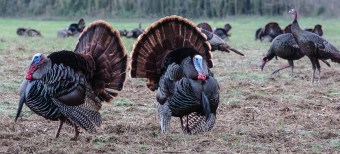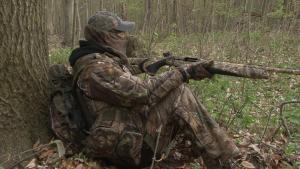A few months ago we talked about turkey hunting and some of the elements that can lead to success. Now that Fall has arrived, it’s time to re-visit the subject with some more details.For as awkward looking as they are, wild turkeys are wily prey and can be hard to hunt. I wouldn’t go so far as to say that they’re particularly smart, but they get by on a ton of survival instinct and they do have wicked eyesight. Tracking and bagging these birds can be challenging – and that’s why it can be so much fun.
As always, be sure to know the nature of the area you’re hunting within (private vs. public land) and what licensing you may need. Be aware of the season dates, times of the day that you can hunt and any other restrictions that may apply.
Speaking of seasons – that’s another big consideration for how you approach your hunt. Like most birds and animals, turkeys are bound by their mating season and the behaviors that come with it. In the Spring when these birds have love on their minds, the Toms can be a little preoccupied and the tactics to attract them can be more straightforward. Whether it’s seeking out receptive hens or chasing away intrusive juvenile males, the dynamic is fairly predictable. For those who wish to hunt turkeys in the Fall, it’s important to realize that it is quite different from the experience in the Spring. Since the birds are not breeding at this time of year, the hunter must use different tactics to lure them into shooting range. Typically this results in a hunter imitating a hen that is trying to locate other birds from its flock.
and the behaviors that come with it. In the Spring when these birds have love on their minds, the Toms can be a little preoccupied and the tactics to attract them can be more straightforward. Whether it’s seeking out receptive hens or chasing away intrusive juvenile males, the dynamic is fairly predictable. For those who wish to hunt turkeys in the Fall, it’s important to realize that it is quite different from the experience in the Spring. Since the birds are not breeding at this time of year, the hunter must use different tactics to lure them into shooting range. Typically this results in a hunter imitating a hen that is trying to locate other birds from its flock.
Calls
Wild turkeys actually have a complex vocabulary that includes as many as 30 different sounds. Turkeys of all ages and genders are capable of producing a variety of yelps and calls depending on the situation. Hunters typically will only utilize the most common ones, but it can still be a bit of an art form in getting them just right. There are a variety of call types available to purchase, however it’s the box calls that provide beginners with the most consistent sounds.
A few other pointers:
- Spend the few extra bucks for a good quality call
- Know when to use each type of call depending on the circumstance – coyote vs. owl etc.
- Listen to the birds in the area – focus on the cadence and rhythm of your calls
- Vary volume levels
- Keep it short – sometimes less is more
- Get as close as you can – some would suggest 100 – 200 yds. is an ideal distance
- Try and develop a sense of when to stop your calls and just sit tight (play hard to get)
- Be sure to practice your calls before you hit the trail
Decoys
Another common method to attract turkeys is by using a decoy. Turkeys are territorial, so if a gobbler happens to see a hen decoy or another Jake or Tom infringing on their turf, he is likely to take notice. It’s often that one-two punch of an effective call and a well-placed decoy that can coax a bird into range.
Be sure to get a decent quality decoy that looks reasonably life-like. It can make a big difference. Set them up not too far from your location (maybe 15 or 20 yds.) and at an angle so that ideally the Tom will have to walk past you to get to it. At that distance you’ll still have a shot if the bird gets hung up on the far side and your shot pattern will have room to open up.
Camo
With that great eyesight that wild turkeys have, you’ll have to be extra diligent with your camo coverage. Be sure to use a pattern that matches the environment and keep your hands, face and neck covered. The last thing you want to do is to spook a big Tom by not paying attention to the small details.
Bird Behavior & Tactics
Wild turkeys have distinct patterns of behavior that can help hunters locate and track them effectively. Bagging them can be tricky for sure, but obviously the more you know, the better off you’ll be.
Behavior Basics
Turkeys spend most of their time on the ground during the day, but they sleep in trees at night. Since they can’t see well in the dark, this provides protection from predators.
Turkeys are quite active in the early morning hours and make a circuit through feeding and cover areas throughout the day. They begin to work their way back towards their roost areas as night approaches.
Scout the Area
Heading out on a scouting trip before a hunt can be crucial to your success. Get a good vantage point for some glasswork to be able to determine roost locations and movement patterns. This is usually best to do the night before.
Look for Signs
Watch for telltale signs that birds may be active in the area. This would include scat, tracks, feathers, dusting areas and scratch marks.
Get an Early Start
Getting ahead of the game in the early morning hours is standard for most all hunting ventures, but be sure to use the same strategy for the evening as well. You’ll want to be established in your chosen spot at least a few hours before the birds begin to make their way back to the roosting area.
Location, Location, Location
Ideally, your scouting efforts will have revealed the routes that birds take between their roost and their morning food. This is always a good place to set up and wait. Give the birds some space and look for obvious trails, travel corridors and pinch points and allow yourself a wide shooting lane. Turkeys are also not fans of high winds and bad weather. You can have some success finding them on lee hillsides and secluded valleys or draws that offer protection from the elements. After a rain? Look for sunny, flat areas like the edges of a field where they are likely to be preening or trying to warm up.
wait. Give the birds some space and look for obvious trails, travel corridors and pinch points and allow yourself a wide shooting lane. Turkeys are also not fans of high winds and bad weather. You can have some success finding them on lee hillsides and secluded valleys or draws that offer protection from the elements. After a rain? Look for sunny, flat areas like the edges of a field where they are likely to be preening or trying to warm up.
Build a Blind
A hide made from natural materials or camouflage fabric is a good option if you want to get more comfortable or if you have fidgety kids hunting with you. They work well in clearings and on ridges and field edges and can be effective when birds are twitchier as night approaches. Be sure to wear dark clothing and cover your face so that you blend-in with the blind’s dark interior.
The Tree Lean
This classic technique works well, but requires that you have the ability to sit VERY still while waiting for a Tom to approach. Ideally find a tree larger than shoulder width for better concealment and be sure that your camo is on-point. Find an area that is comfortable enough that you won’t have to shift around too much and ensure that you’re able to effectively shoot your weapon from this seated position. Also be aware that establishing cover like this quickly can come in handy if you utilize the flock-buster / run-&-gun technique of scattering groups of gathered bids.
Wild turkey hunts can be a ton of fun and will definitely test your skill. If you typically hunt other game only, you may want to give it a chance.
Sign up for K-Var’s weekly newsletter and discounts here.

Leave a Reply